-
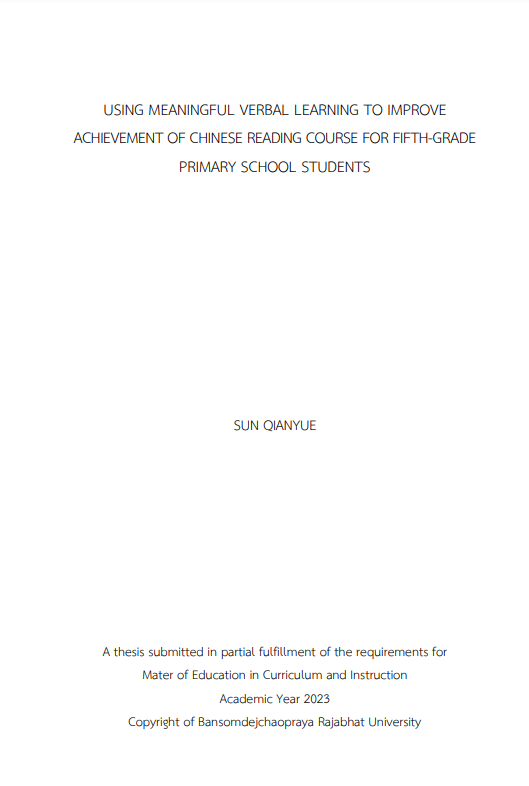
The purposes of this research were 1) To improve achievement of Chinese
reading course using meaningful verbal learning and 2) To compare student’s
achievement of Chinese reading course between before and after the implementation base on meaningful verbal learning. The sample group were 30 fifth-grade primary school students with 1 class from Yantai Oriental Foreign Language Experimental School, Shandong City, China, those who obtained through the cluster random sampling. The research instruments involved 1) lesson plans according to the meaningful verbal learning theoryand 2) Chinese reading test. The data was statistically analyzed by mean, standard deviation, and t-test for dependent samples.
The results were found that:
1) The improvement achievement of Chinese reading course using meaningful
verbal learning, the researcher developed 3 lesson plans base on meaningful verbal learning by studied the documents and research related from many researchers then synthesized into 5 steps: 1) Attention 2) Transformation3) Evaluation 4) Application and 5) Summary. After students have learned according to the lesson plans: 1) Short story,
2) Narrative, and 3) Ancient poetry base on meaningful verbal learning theory. The result showed that, students’ achievement of Chinese reading course the average score after learning was 21.90 which was higher than the average score before learning was 15.17.
2)The comparison of students' achievement of Chinese reading score before
and after the implementation base on meaningful verbal learning of primary school students. The results showed overall that, students’ achievement of Chinese reading course after learning higher than before learning statistically significant at the level .01.
Keywords: Achievement of Chinese reading, Meaningful verbal learning,
Primary school students
-
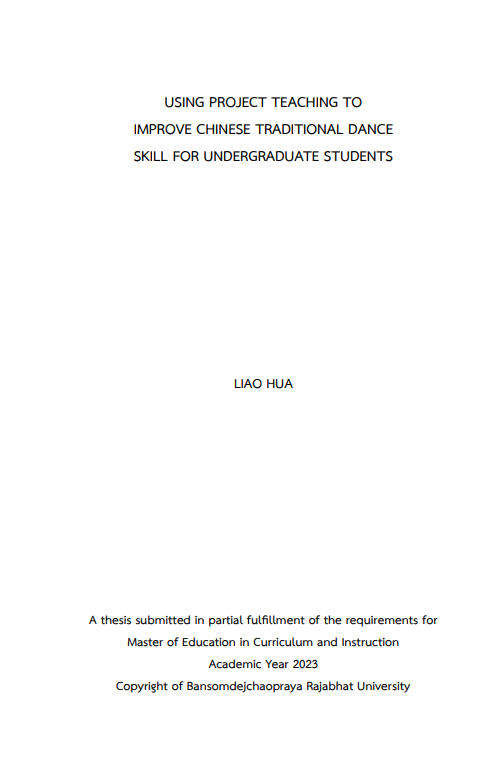
The purpose of this research was 1) to improve Chinese tradition dance skill using project teaching for undergraduate students 2) to compare students’ Chinese traditional dance skill between before and after the implementation base on using project teaching. There were 33 students in the second-year for undergraduate students of the Chongqing Media College, Chongqing City, China, in the second semester of the academic year 2023. those who obtained through the cluster random sampling. The research instruments involved Through practical testing 1) used as a guide for developing a learning program
through learning objectives, content, guidelines for organizing measurement and assessment of learning activities, and teacher guidance. In addition, studied of concepts, theories related to the theory from documents, textbooks, and related research to create a learning management plan. 2) Practical testing. The data was statistically analyzed by mean, standard deviation, and t-test for dependent samples.
The results were found that:
1. The improvement Chinese tradition dance skill using project teaching for
undergraduate students, the researcher studied the documents and related research about project teaching from many researchers and synthesized into 4 steps used for lesson plans development: 1) Determine the project, 2) Implementing the project, 3) Show case, and 4) Summary and Evaluation. The data analysis was assessment of the quality of the lesson plan according to project teaching by 3 experts, and the results are shown overall that, the
suitability of the research objectives has the most suitable. After student have learned according to the lesson plans 1) Tibetan Dance; 2) Dai Dance; and 3) Northeast Yangko Dance, the result showed that, students’ Chinese Traditional Dance Skill the average score after learning was 127.33 which was higher than the average score before learning was 93.96.
2. The comparison of students’ Chinese Traditional Dance Skill between before
and after learning using project teaching of undergraduate students. The results showed overall that, students’ Chinese Traditional Dance Skill after learning higher than before learning statistically significant at the level .01.
Keywords: Chinese Traditional Dance Skill, Project Teaching, Undergraduate
Students
-
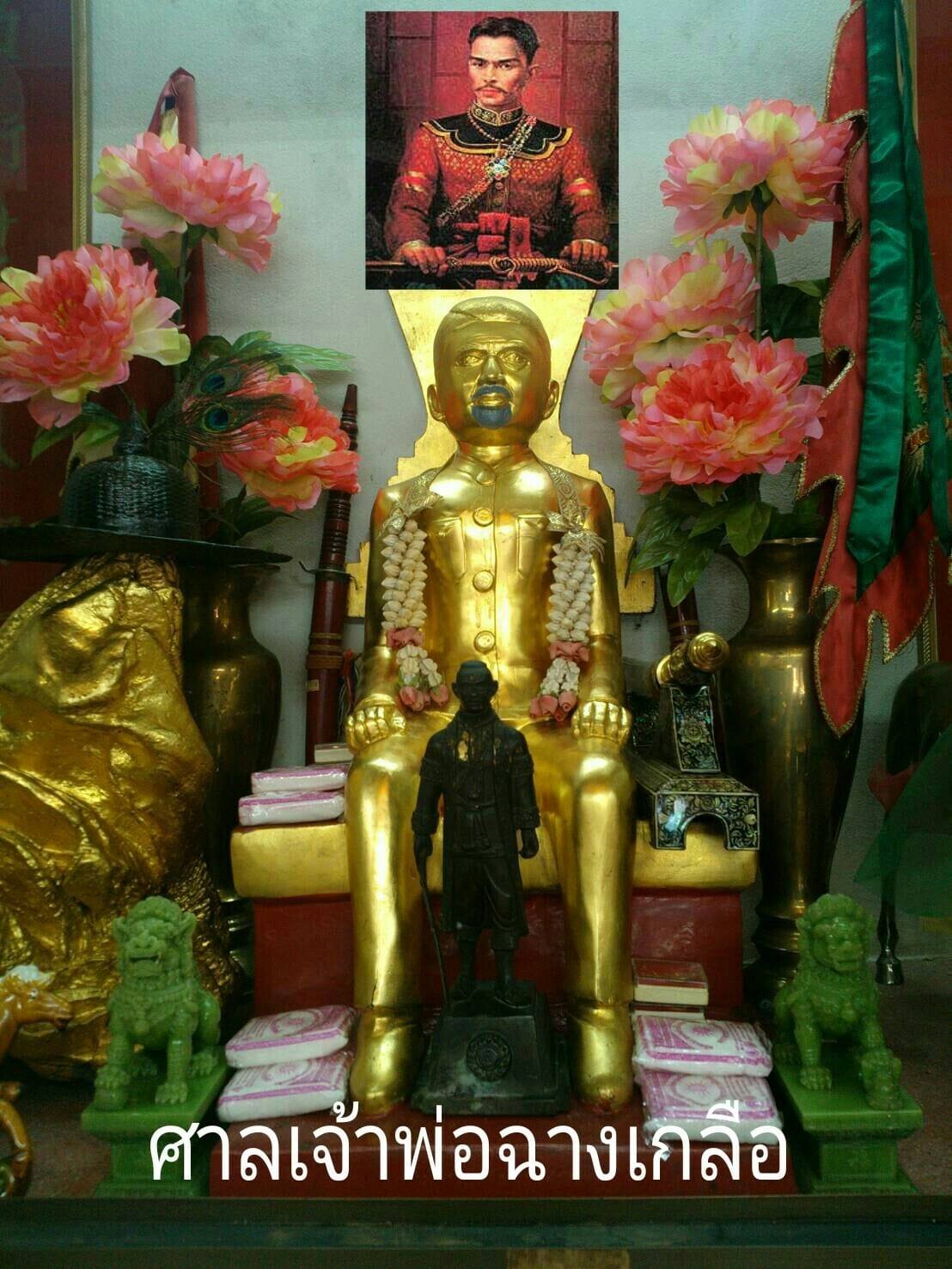
ศาลเจ้าพ่อฉางเกลือ ในย่านวังหลัง ซึ่งเป็นศูนย์รวมจิตใจของชาวบ้านพรานนก มีประวัติว่าเจ้าพ่อฉางเกลือเกี่ยวข้องกับสมเด็จพระเจ้าตากสินมหาราชที่สร้างฉางเกลือเพื่อใช้ในราชการสงคราม ปัจจุบันผู้คนมาสักการะขอพรด้านสุขภาพ
-
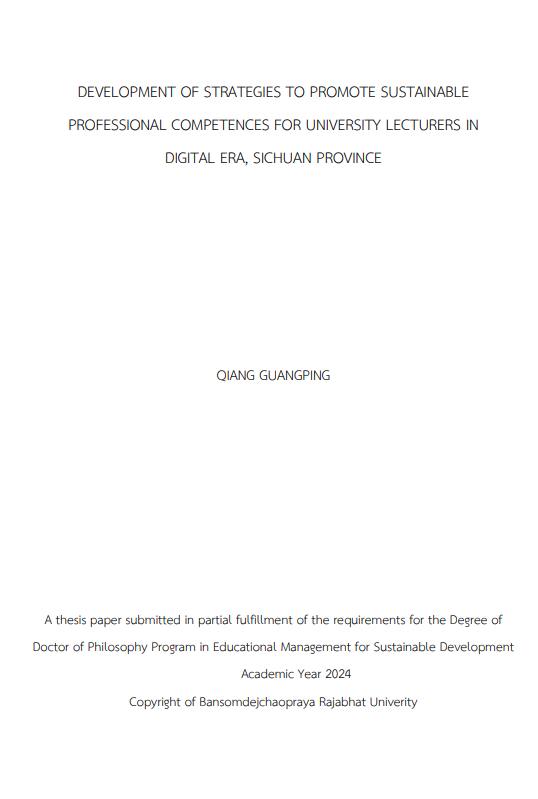
The objectives of this research were: 1) to study the current situation of sustainable professional competences for university lecturers in the digital era, Sichuan Province; 2) to provide strategies for improving sustainable professional competences for university lecturers in the digital era, Sichuan Province; 3) to evaluate the adaptability and feasibility of these strategies. The sample group of this research comprised 377 university lecturers in Sichuan Province, selected by systematic and simple random sampling. The interview group included 10 experts from representative universities in Sichuan Province. Experts who evaluated the adaptability and feasibility of the strategies consisted of high-level administrators from each representative university, totaling 7 people.
The sample group consisted of 377 university lecturers from ten universities in
Sichuan Province, selected using systematic and simple random sampling methods. Data
were collected through questionnaires, structured interviews with ten experts, and
evaluations by seven high-level administrators. The research instruments included a
questionnaire to gather quantitative data on lecturers' competences, structured
interviews to gather qualitative insights from experts, and evaluation forms to assess the feasibility of the proposed strategies.
The findings revealed that while the overall level of sustainable professional
competences was high, there was significant variation across different aspects. Subject
knowledge was the highest-rated competence, while sustainable learning showed the
greatest need for improvement. The study developed 26 strategies for improving
professional competences, including seven for subject knowledge, five for teaching
ability, eight for digital skills, and six for sustainable learning. The evaluation of these
strategies demonstrated that they were highly adaptable and feasible.
The research recommends that the Education Department implement policies
supporting continuous professional development, that universities integrate the
strategies into institutional policies to encourage interdisciplinary collaboration, that
society supports universities by providing opportunities for real-world learning, and that lecturers actively seek opportunities to improve their competences through continuous learning and self-assessment.
Keywords: Sustainable Professional Competences, University Lecturers, Digital
Era, Sichuan Province, Strategies to promote
-
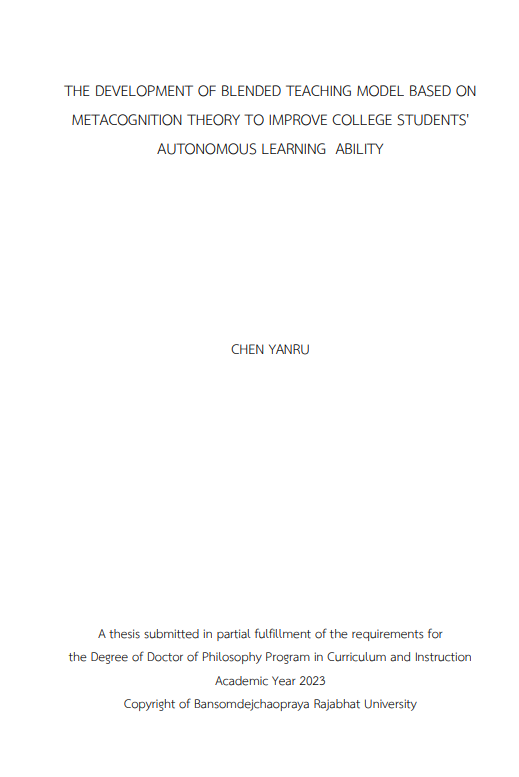
-
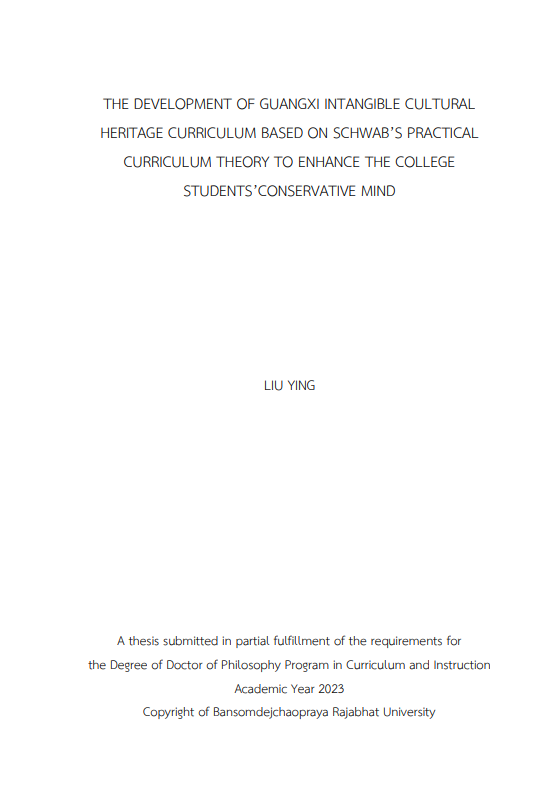
The research objectives were: 1) to investigate the current situation and
effectiveness of the intangible cultural heritage curriculum and students’ conservative mind, 2) to develop Guangxi intangible cultural heritage curriculum based on Schwab’s practical curriculum theory to enhance the college students’ conservative mind, 3) to assess the efficiency of Guangxi intangible cultural heritage curriculum based on Schwab’s practical curriculum theory through comparing the college students ’conservative mind before and after the implementation of curriculum. The sample group were 1) The population groups for this study are 200 fresh students of art design major in Guangxi University of Science and Technology.; 2) 90 students who participated in a questionnaire survey; 3) 30 students who participated in a quasi-experimental study. This research instruments includes 1) the Guangxi intangible cultural heritage conservative mind Questionnaire for college students; 2) the Guangxi Intangible Cultural Heritage Curriculum lesson plan; 3) the Conservative Mind Scale for college Students. Research data be collected were analyzed by statistical measures such as percentage, mean, standard deviation, t-test values, and p-values.
The results of this study are as follows:
1. College students' conservative mind is at high level (X-Bar=4.12), in the three dimensions of conservative mind, “Attitudes towards the safeguarding of Guangxi intangible cultural heritage” is the lowest rank.
2. Based on Schwab’s practical curriculum theory, 30 lessons of Guangxi
intangible cultural heritage curriculum in class hours are developed.
3. After taking part in the 30 lessons course, the conservative mind of the
students was significantly improved (t=28.13, Sig.=000). At the same time, the three dimensions of conservative mind including knowledge, attitudes, acts have been improved.
Keywords: Guangxi Intangible Cultural Heritage Curriculum; Conservative Mind; Schwab’s Practical Curriculum Theory
-
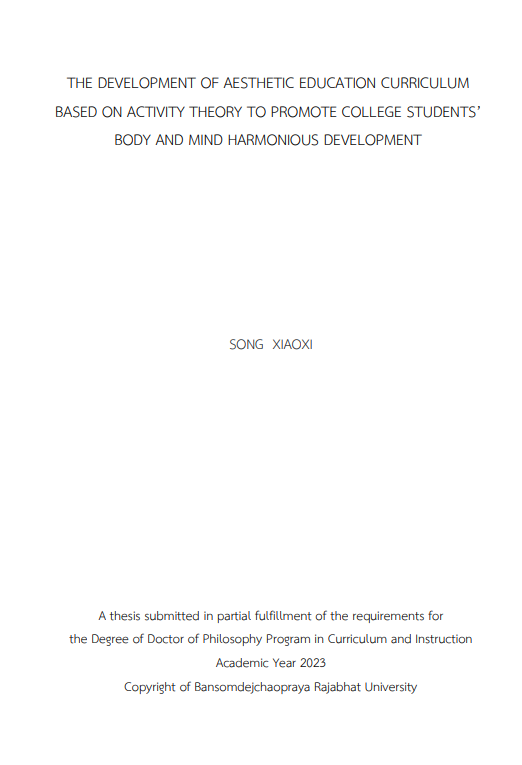
The research objectives were: 1) to investigate the current situation and
effectiveness of college students’ body and mind harmonious development, 2) to develop aesthetic education curriculum based on activity theory to promote college students’ body and mind harmonious development, 3) to assess the aesthetic education curriculum based on activity theory through comparing to the college students’ body and mind harmonious before and after the implementation of curriculum. the population of this study was 300 freshman students majoring in art and design in 2023 at Guangxi University of Science and Technology. the samples are 170 freshman students participated in a survey on the status of body and mind harmonious development of university students and 30 freshman students participated in the pilot study. this research tool were questionnaires on the current status of body and mind harmonious development of college students and Body and Mind Harmonious Development Scale. the statistic used were frequency, percentage, mean, standard deviation, and t-test for dependent sample.
The results of this study were as follows:1) the current situation and
effectiveness of college students’ body and mind harmonious of respondents were in high level, considering each item separately, it was found that, “Physical health” was the highest rank, followed by “Value of life” “Aesthetic ability”, “Social adaptation”, “Psycho emotional” respectively, 2) the goal of the aesthetic education curriculum based on activity theory to promote college students’ body and mind harmonious development was to improve the body and mind harmonious development of freshmen students. The curriculum consisted of five units, totaling 24 hours of "The aesthetic education curriculum based on activity theory to promote college students’
body and mind harmonious development" were offered. 3) after attending the 24-hour course, there was a significant increase in the development of body and mind harmonious development of students (t = 6.43). sig. = 0.00). at the same time, the five dimensions of value of life, aesthetic ability, physical health, social adaptation, and psycho-emotional were also improved.
Keywords: Immersive learning; Tour guide oral communication; Virtual reality
environment; PIE teaching model.
-
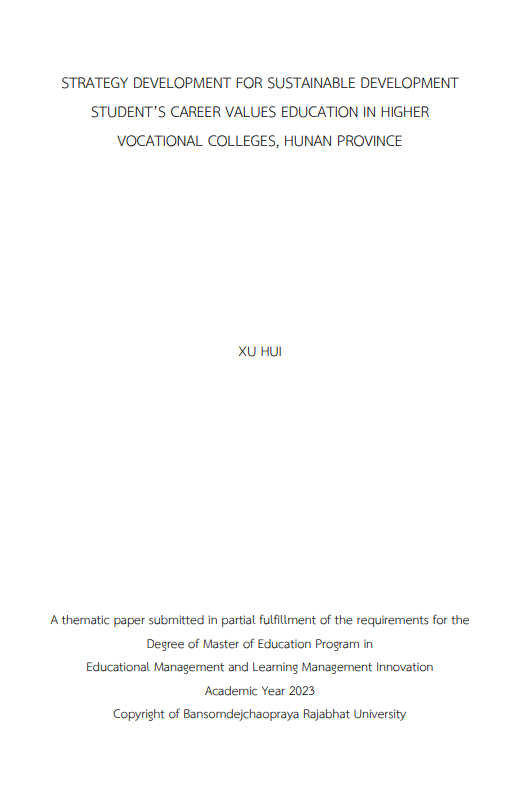
The objectives of this research were 1) to study the current situation of career
values education in higher vocational colleges in Hunan Province, 2) to propose
strategies for the development of career values education in higher vocational colleges
in Hunan Province, and 3) to evaluate the suitability and feasibility of the strategies for
the development of career values education in higher vocational colleges in Hunan
Province, including the following four aspects: 1) career ethics, 2) career skills, 3) career
psychology, and 4) career planning. The sample group of this research comprised 384
students from higher vocational colleges in Hunan Province, selected through
systematic and simple random sampling methods. Additionally, the interview group
consisted of 12 career guidance experts. The experts who evaluated the suitability and
feasibility of the strategies were high-level administrators and career education experts
from 6 colleges.
A mixed-methods approach was employed. Quantitative data were gathered
from 384 students using a systematic random sampling technique, while qualitative
insights were obtained through structured interviews with 12 career guidance experts
from six higher vocational institutions. Data analysis included document analysis,
questionnaires, structured interviews, and evaluation forms. Statistical tools such as
percentages, averages, and standard deviations were used, along with SWOT and TOWS
matrix analyses.
The results revealed that the overall level of career values education is high
but unbalanced, with career skills being the most developed and career planning
lagging behind. A total of 29 strategies were proposed: 5 for career ethics, 6 for career
skills, 9 for career psychology, and 9 for career planning. The strategies were evaluated
by experts and rated highly for adaptability and feasibility, achieving average scores
between 4.5 and 5.0.
The study recommends that colleges should integrate these strategies into
their curricula and provide continuous professional development opportunities for
educators. Society should actively collaborate with educational institutions by offering
mentorship programs and supporting students’ career development through
internships. Finally, students should take an active role in aligning their career
development with industry needs, regularly evaluating their career plans, and
enhancing their professional skills.
Keywords: Career Values Education, Higher Vocational Colleges, Hunan
Province, Sustainable Development, Educational strategies
-
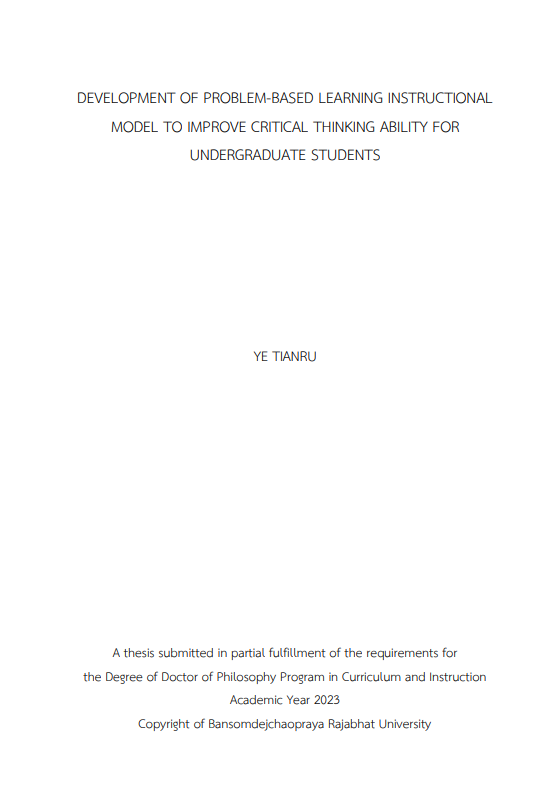
The objectives of this research were threefold: 1) to investigate the factors that enhance critical thinking abilities among undergraduate students; 2) to develop a problem-based learning instructional model aimed at improving critical thinking skills in this cohort; and 3) to evaluate the effectiveness of the implemented instructional model in fostering critical thinking. The study was executed in three distinct phases corresponding to each research objective. In Phase 1, the study population comprised 150 undergraduate students enrolled in the Innovation Training Course at Guangxi Minzu University during the first semester of the 2024 academic year, along with three lecturers responsible for teaching the course. Phase 2 involved the purposive selection of three experts to validate the conformity of the problem-based learning instructional model. In Phase 3, the sample included 50 students enrolled in the Innovation Training Course during the second semester of the same academic year. The research instruments utilized were: 1) questionnaires for students and interview protocols for lecturers; 2) conformity assessment forms for validating the instructional model; 3) lesson plans integrating the problem-based learning model; and 4) scoring rubrics designed to assess critical thinking abilities. Data were analyzed using statistical methods including percentage, mean, and standard deviation.
The research yielded the following results:
1. Two primary factors influencing the critical thinking abilities of undergraduate students were identified: internal factors, including students' positive emotions, learning behaviors, attitudes, and physical health, and external factors, encompassing teaching methods, instructional materials, and the learning environment.
2. The problem-based learning instructional model designed to enhance critical thinking was validated by three experts, achieving 100% conformity with standards of utility, feasibility, propriety, and accuracy. The model was structured around five key components: 1) Principles and Rationale, which involved analyzing the course and students' critical thinking abilities, integrating findings from the first objective; 2) Objectives, derived from the second research objective; 3) Content, informed by the course structure used in the experimental phase; 4) Teaching Methods and Materials, aligned with the problem-based learning model; and 5) Evaluation, conducted using the critical thinking scoring rubric.
3. Post-experiment analysis indicated that 22% of the 50 students achieved
an 'excellent' level of critical thinking, 70% attained a 'good' level, and 8% were at a
'fair' level. These outcomes align with the research hypothesis, which predicted that
over 80% of participants would demonstrate a good or higher level of critical thinking
following the problem-based learning instructional model.
Keywords: The Problem-Based Learning Instructional Model, Critical Thinking
Ability, Undergraduate Students
-
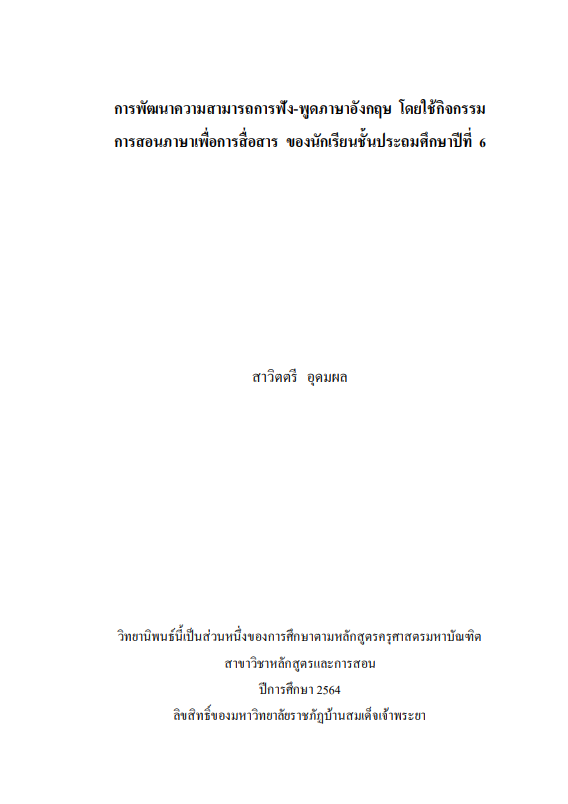
การวิจัยครั้งนี้มีวัตถุประสงค์เพื่อ 1) เปรียบเทียบความสามารถการฟัง-พูดภาษาอังกฤษ ก่อนเรียนและหลังเรียนโดยใช้กิจกรรมการสอนภาษาเพื่อการสื่อสารของนักเรียนชั้นประถมศึกษาปีที่ 6 2) ศึกษาความพึงพอใจของนักเรียนที่มีต่อการจัดกิจกรรมการสอนภาษาเพื่อการสื่อสาร ของนักเรียนชั้นประถมศึกษาปีที่ 6 ประชากร คือ นักเรียนชั้นประถมศึกษาปีที่ 6 โรงเรียนวัดลาดประทุมคงคาราม อำเภอลาดบัวหลวง จังหวัดพระนครศรีอยุธยา ภาคเรียนที่ 1 ปี การศึกษา 2563 จำนวน 20 คน เครื่องมือที่ใช้ในการวิจัย คือ แผนการจัดกิจกรรมการเรียนรู้การจัดกิจกรรมการสอนภาษาเพื่อการสื่อสาร จำนวน 4 เรื่อง 16 แผน แบบประเมินความสามารถด้านการฟัง-พูดภาษาอังกฤษ จำนวน 4 ชุด และ แบบสอบถามความพึงพอใจ จำนวน 12 ข้อ สถิติที่ใช้ในการวิเคราะห์ข้อมูลได้แก่ ค่าเฉลี่ย ร้อยละ ส่วนเบี่ยงเบนมาตรฐาน และทดสอบสมมติฐานโดยใช้
t - test (Dependent Samples)
ผลการวิจัยพบว่า
1. นักเรียนชั้นประถมศึกษาปีที่ 6 ที่เรียนโดยใช้กิจกรรมการสอนภาษาเพื่อการสื่อสารมีความสามารถการฟัง-พูดภาษาอังกฤษ หลังเรียนสูงกว่าก่อนเรียนอย่างมีนัยสำคัญทางสถิติที่ระดับ .05
2. นักเรียนชั้นประถมศึกษาปีที่ 6 ที่เรียนโดยใช้กิจกรรมการสอนภาษาเพื่อการสื่อสารมีความพึงพอใจต่อการเรียนรู้โดยใช้กิจกรรมการสอนภาษาเพื่อการสื่อสารโดยร่วมอยู่ในระดับมาก
คำสำคัญ : การสอนภาษาเพื่อการสื่อสาร; ความสามารถการฟัง-พูดภาษาอังกฤษ
-
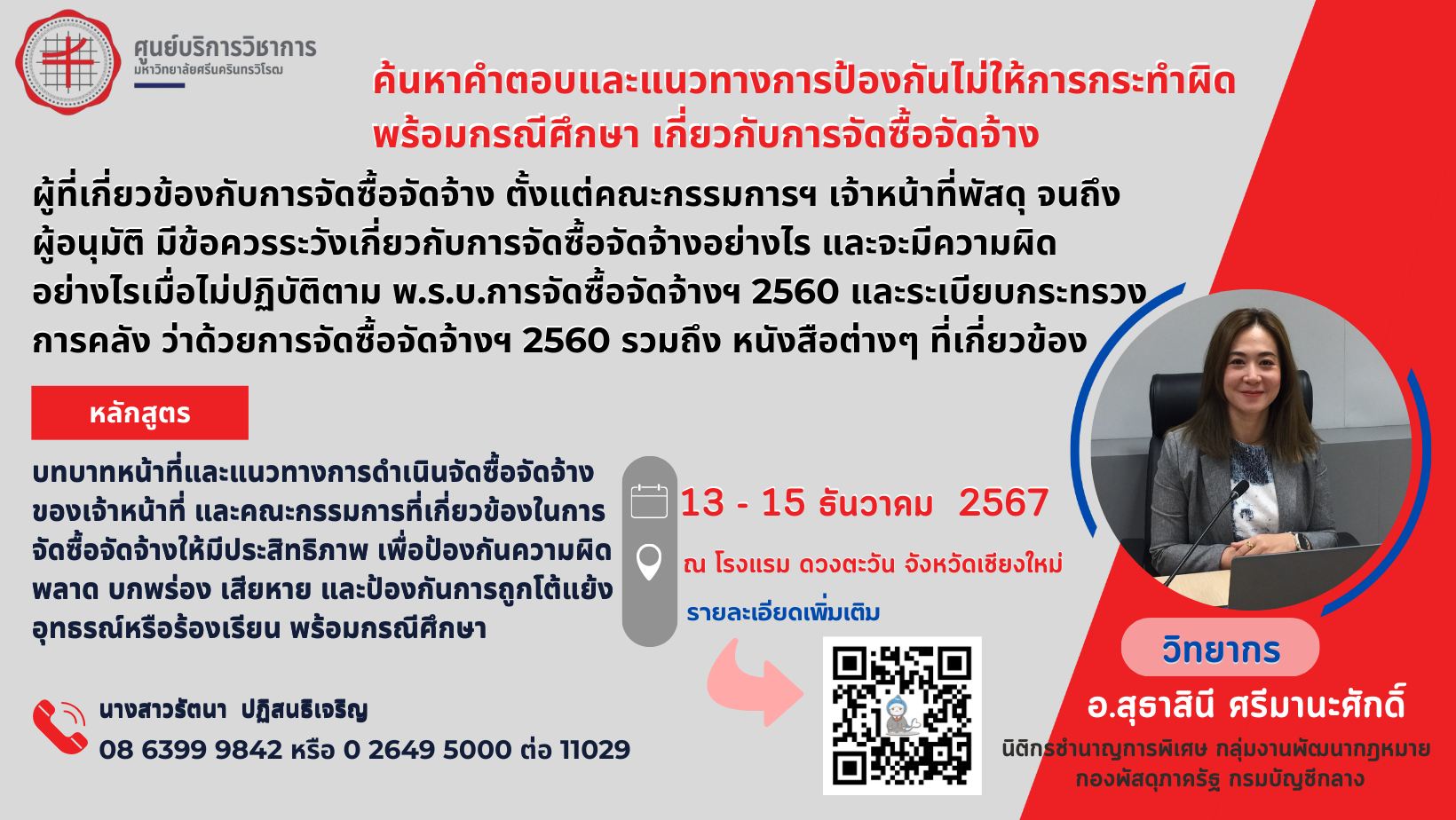
ศูนย์บริการวิชาการ มหาวิทยาลัยศรีนครินทรวิโรฒ ขอเชิญบุคลากรในหน่วยงานของท่านเข้าร่วม โครงการอบรมเชิงปฏิบัติการ หัวข้อ "บทบาทหน้าที่และแนวทางการดำเนินจัดซื้อจัดจ้างของเจ้าหน้าที่ และคณะกรรมการที่เกี่ยวข้องในการจัดซื้อจัดจ้างให้มีประสิทธิภาพ เพื่อป้องกันความผิดพลาด บกพร่อง เสียหาย และป้องกันการถูกโต้แย้ง อุทธรณ์ หรือร้องเรียน พร้อมกรณีศึกษา"
รายละเอียดการอบรม
วันที่จัดอบรม: 13 - 15 ธันวาคม 2567
สถานที่: ห้องประชุม โรงแรมดวงตะวัน เชียงใหม่ จังหวัดเชียงใหม่
วิทยากร: ผู้เชี่ยวชาญจากกรมบัญชีกลาง
ค่าลงทะเบียน
ท่านละ 4,100 บาท (ไม่รวมค่าที่พัก)
ผู้เข้ารับการอบรมจากหน่วยงานราชการสามารถเบิกค่าลงทะเบียนจากต้นสังกัดได้ตามระเบียบกระทรวงการคลัง และไม่ถือเป็นวันลาเมื่อได้รับอนุมัติจากผู้บังคับบัญชา
-
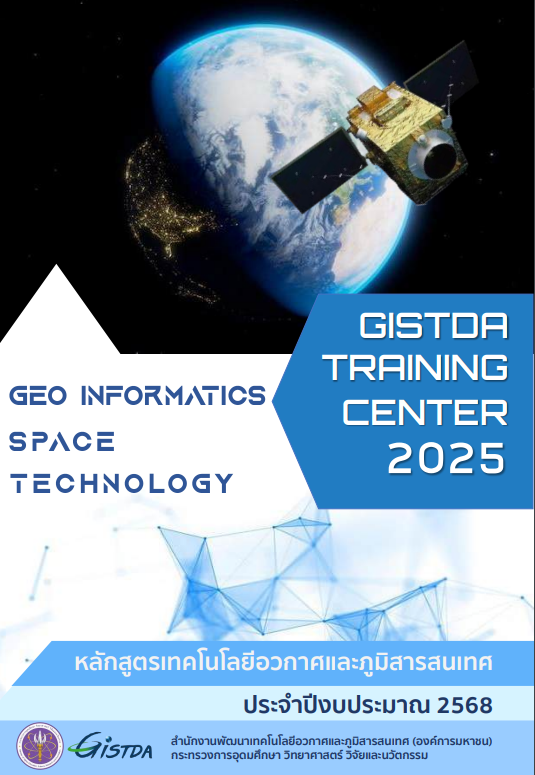
สำนักงานพัฒนาเทคโนโลยีอวกาศและภูมิสารสนเทศ
ขอเรียนเชิญท่านและบุคลากร เข้ารับการฝึกอบรมหลักสูตรฯ ดังกล่าว โดยสามารถ
ศึกษา ติดตามรายละเอียดหลักสูตรฯ และสมัครแบบออนไลน์ผ่านทางเว็บไซต์ https:/training gistda.or.th
ทั้งนี้ ผู้เข้ารับการฝึกอบรมฯ สามารถเบิกจ่าย ค่าลงทะเบียน ค่าเดินทาง และอื่น ๆ ได้ตามระเบียบกระทรวงการคลังว่าด้วยค่าใช้จ่ายในการฝึกอบรม












